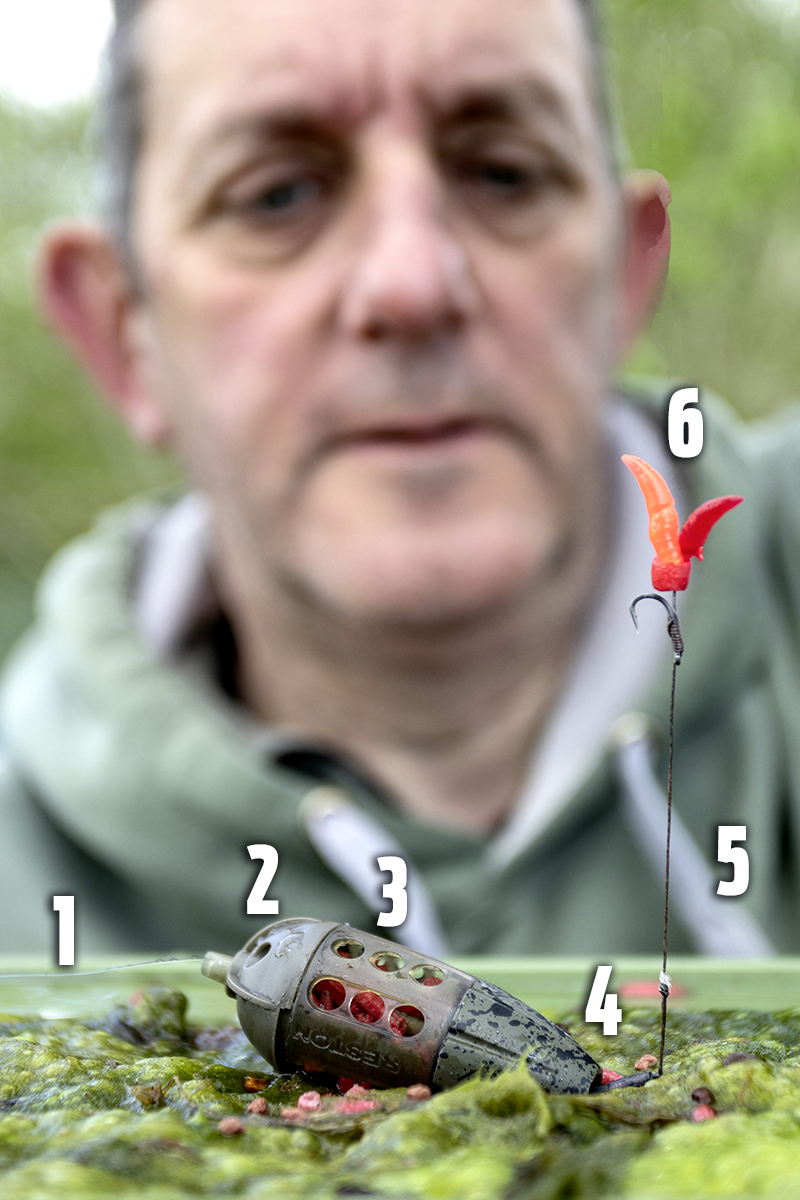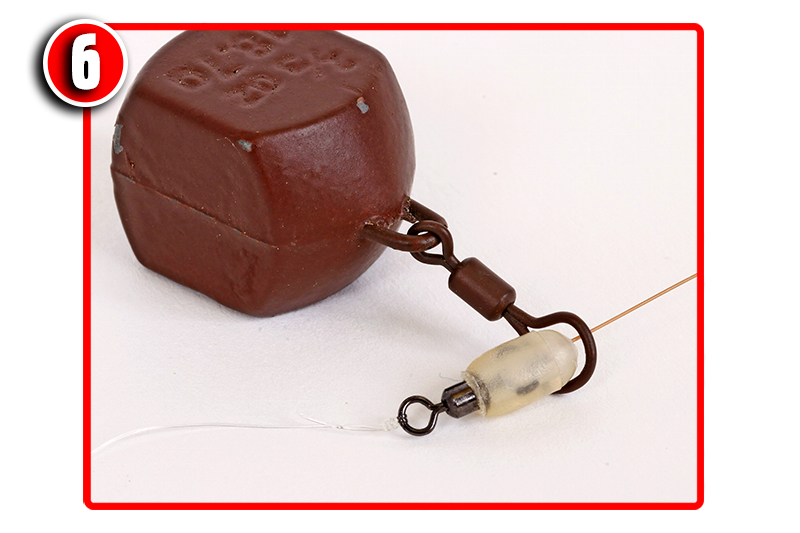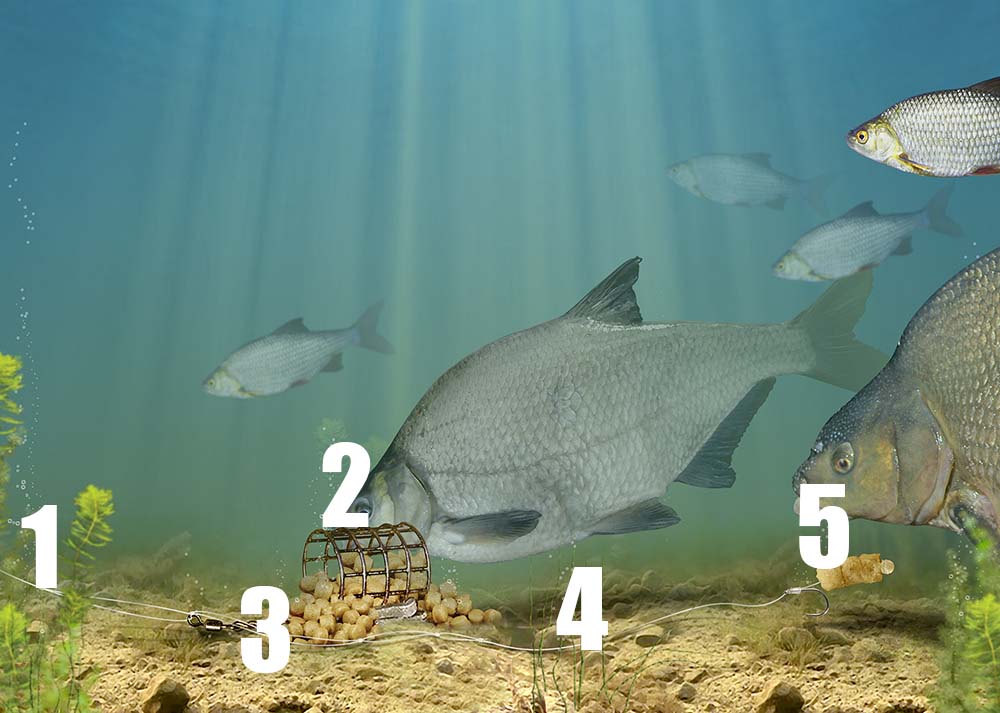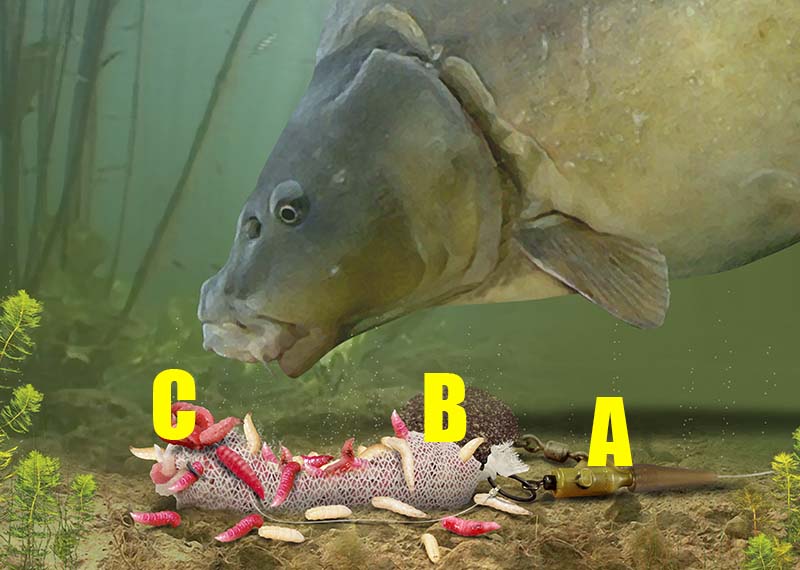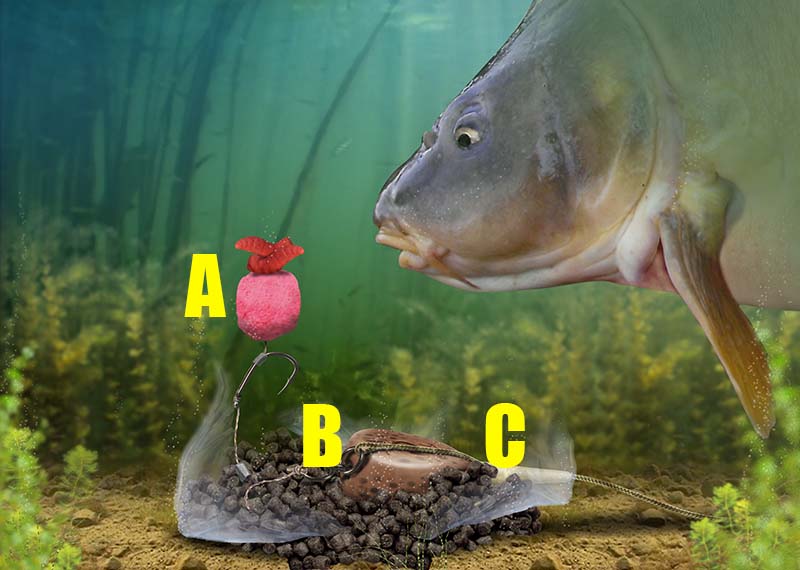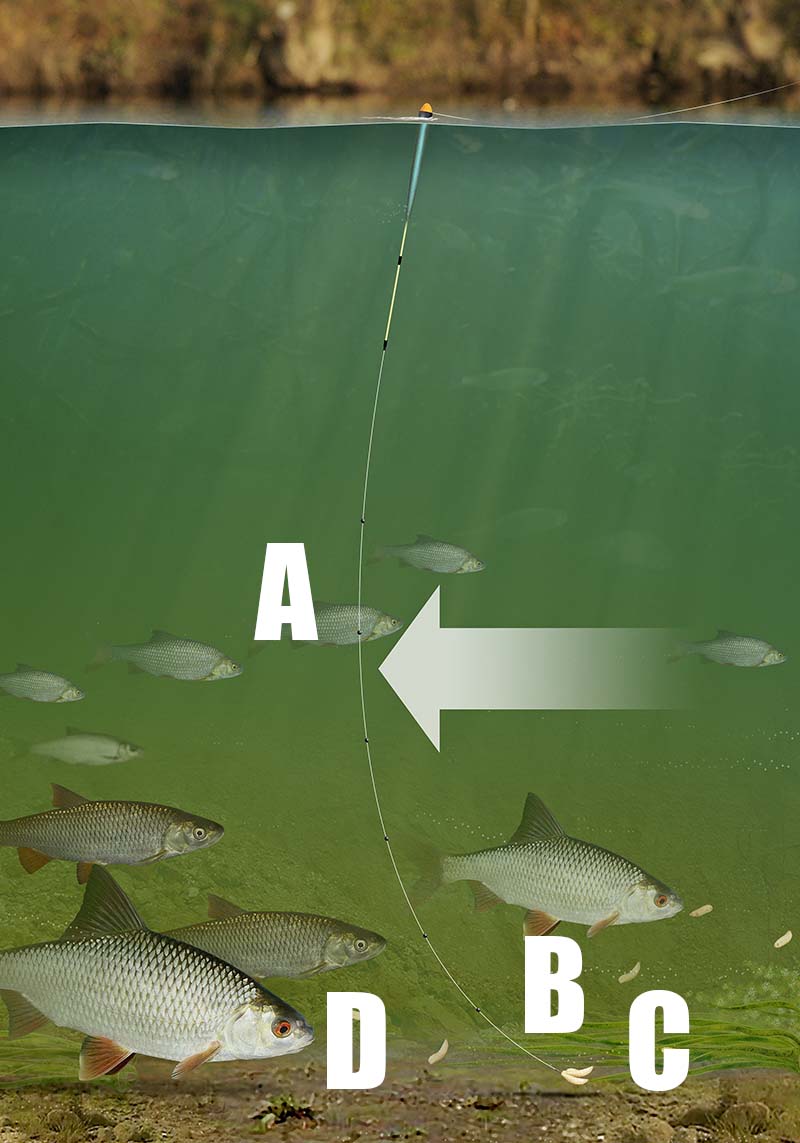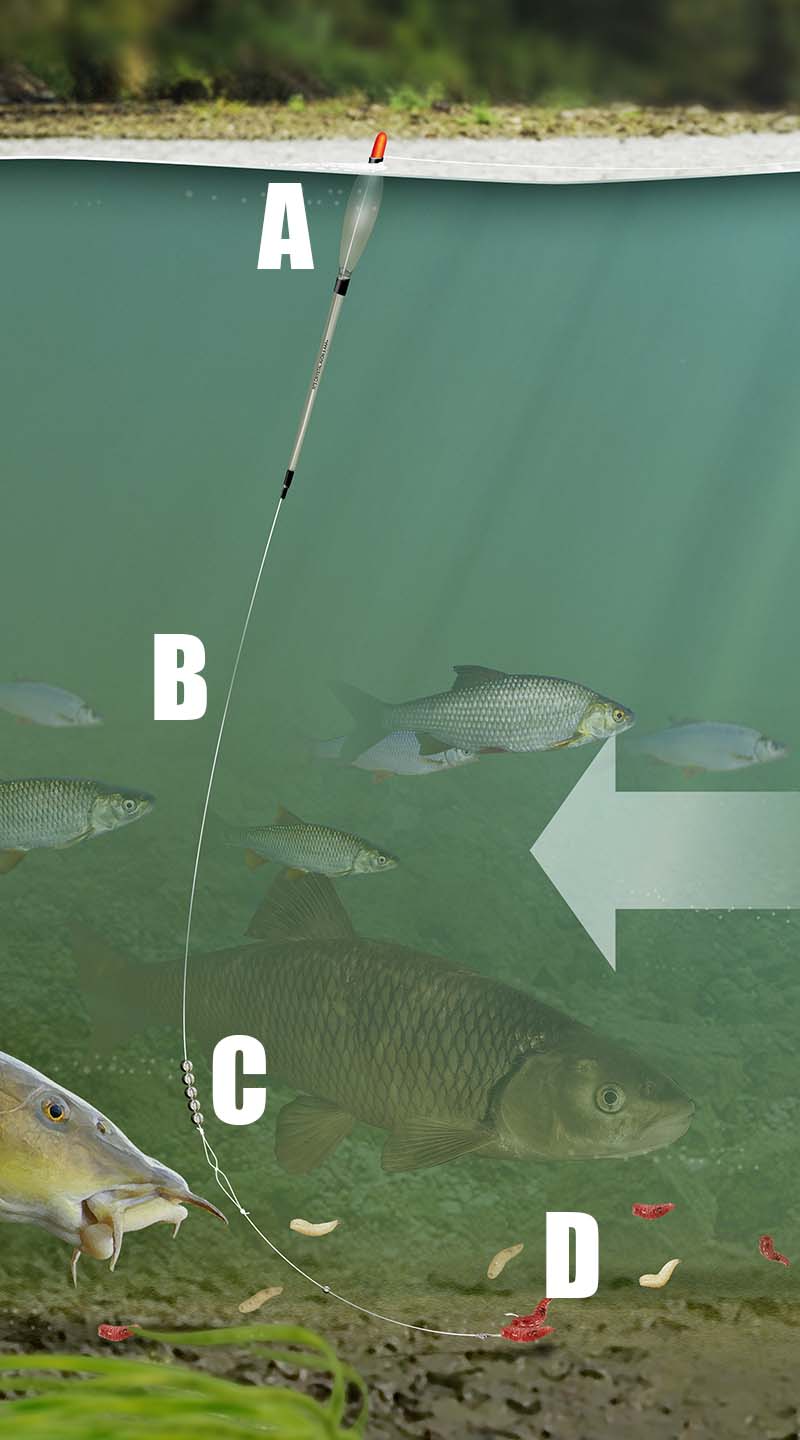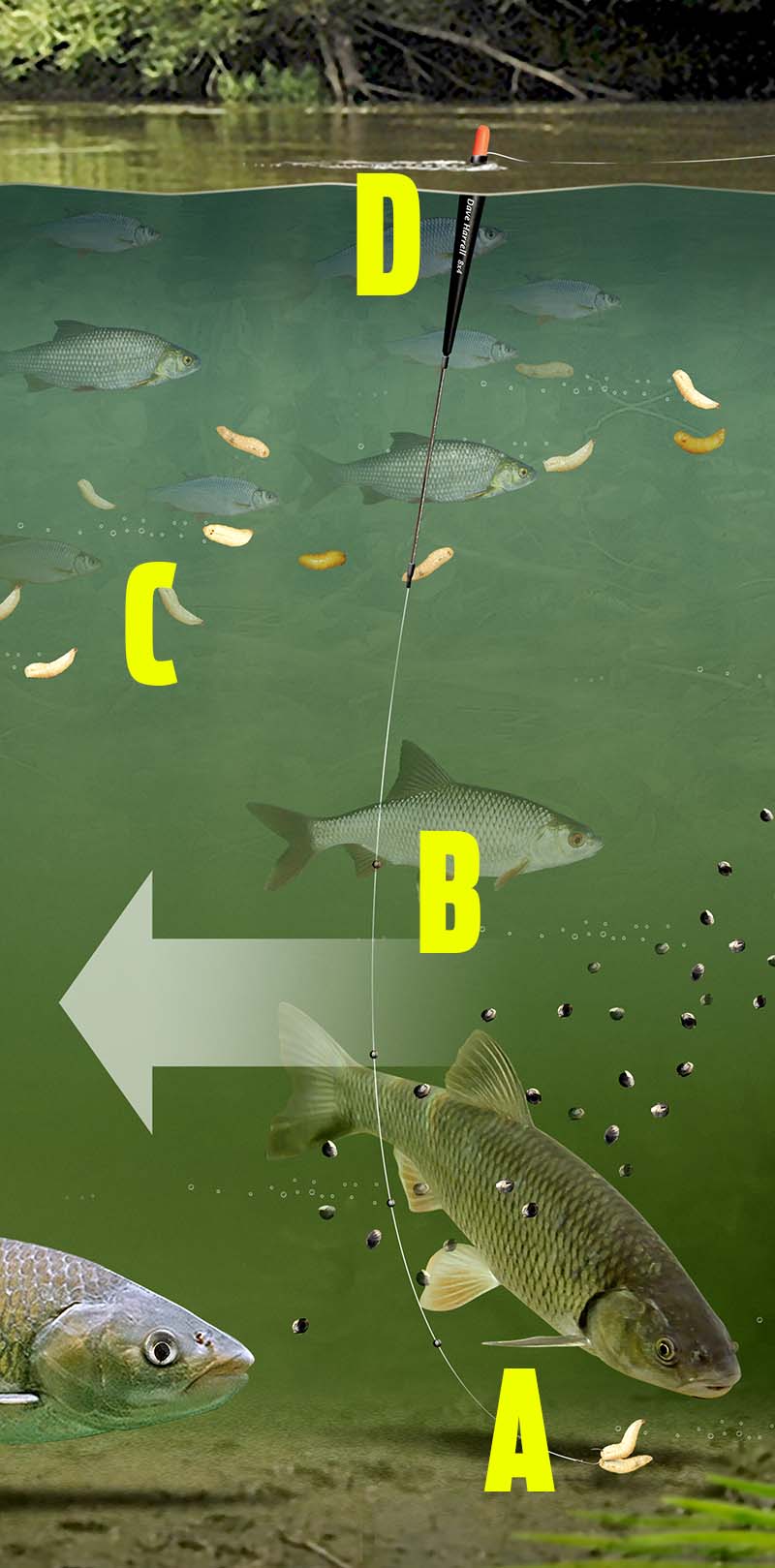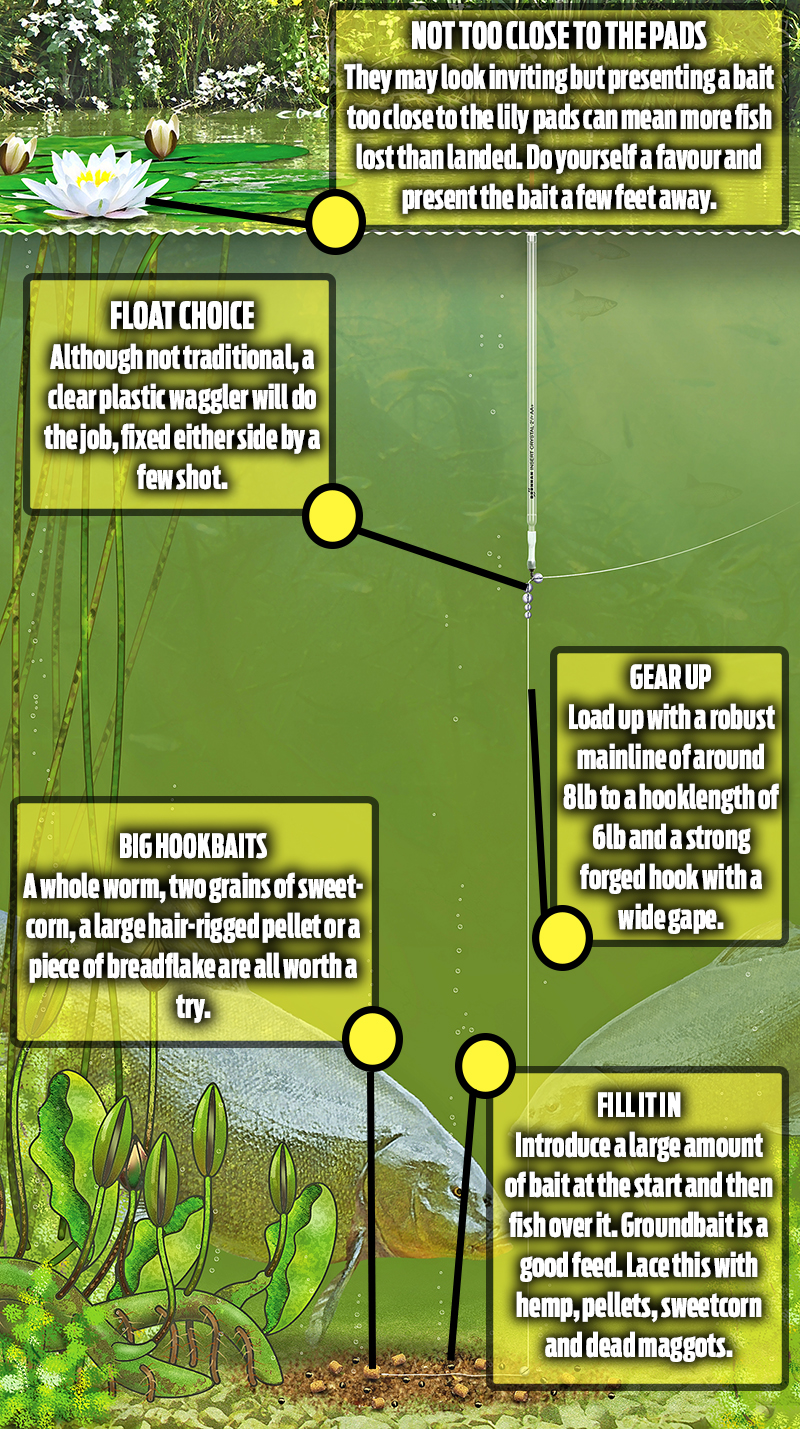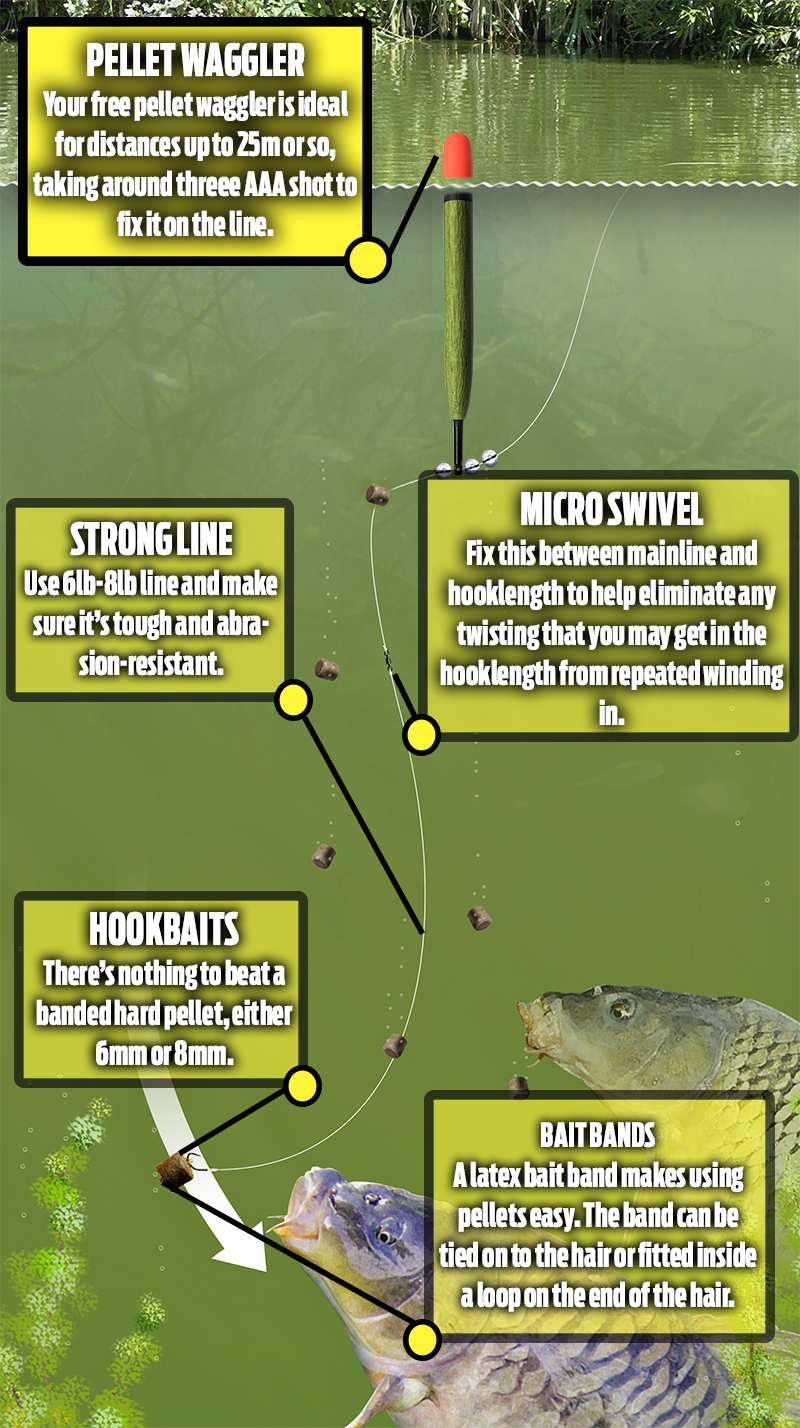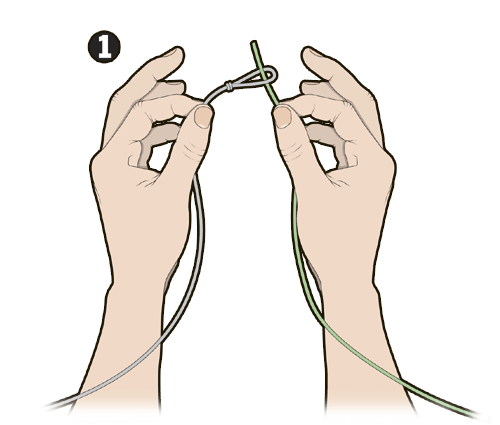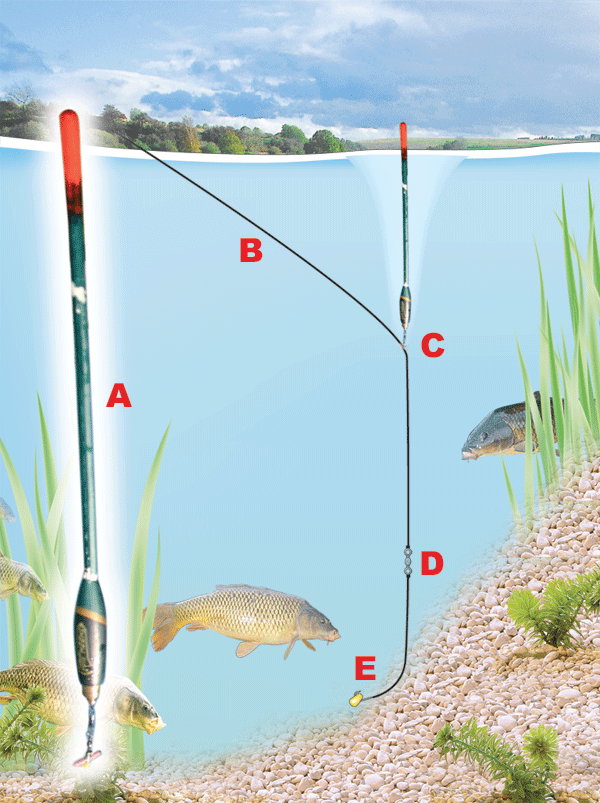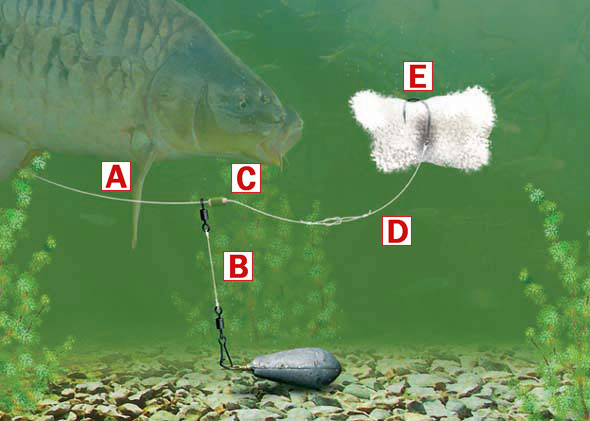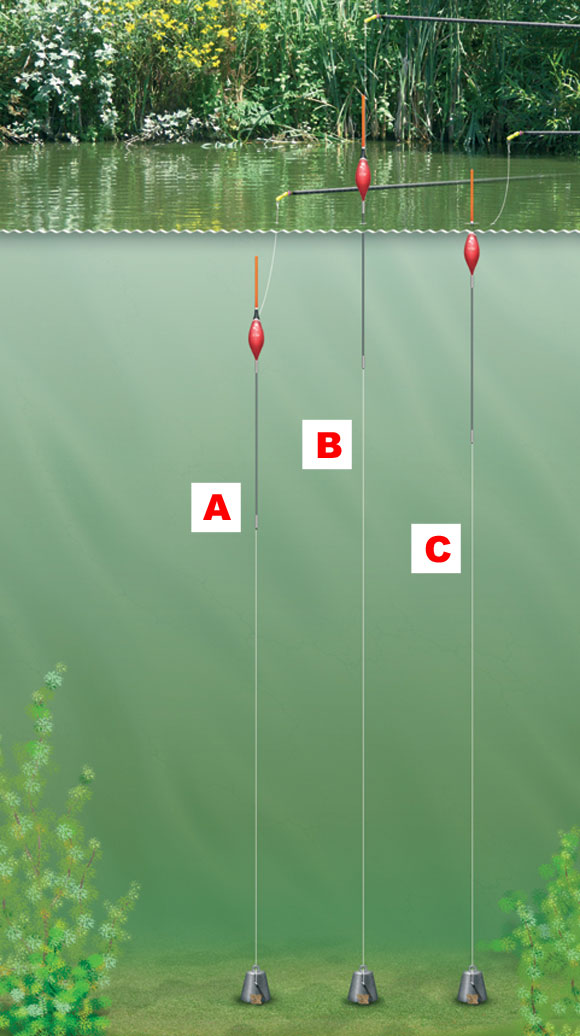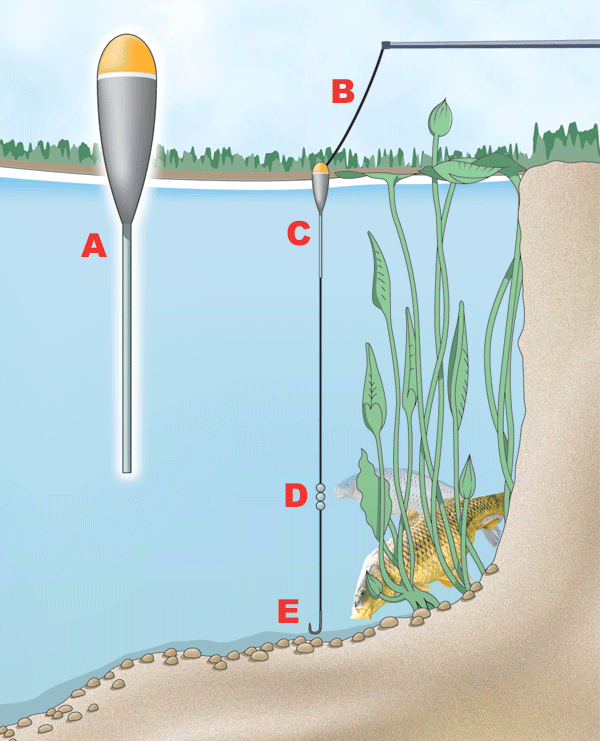Tench Fishing rigs | Maggot feeder rig
Tench love maggots, and a maggot feeder rig gives you the best of both worlds – a pile of maggots presented right on top of your hookbait and an inline feeder set-up to help hook a fish once it has sucked in the bait.
Maggot feeders have accounted for some of the biggest tench caught in the UK, but they also perform brilliantly when you’re after numbers of smaller fish. Repeated casting allows you to build up a bed of bait in the swim.
You’ll need a fair few pints of bait, though, and a gallon fed over a 24-hour session is far from being unheard of!
1) Inline is best
Using a fixed feeder is a no-no on waters with a lot of weed and snags that can tether a fish. Inline maggot feeders, that take a swivel pushed into their end, will stop the feeder and also give you something to attach the hooklength to.
2) Short hooklink
You must have the hookbait near your feed. That means fishing with a short mono hooklength of 4ins hanging directly off the feeder. A shorter link also increases the chance of a hook-up when a tench takes the bait.
3) Fake maggot trick
To help with hooking tench, slip a fake rubber maggot on to the hook shank and over the eye.
This helps to act as a line-aligner and flip the hookbait over when the bait is sucked in by a fish. Alongside this, use three live maggots to impart a bit of extra movement to the hookbait.
4) Go big for baits
You’re going to be using large hooks with this rig (sizes 12 to 14), so pick a hookbait to match. Three or four red or white maggots are perfect.
5) Find a firm lakebed
A maggot feeder rig works best on firm lakebeds that have gravel or hard patches of silt with a minimum of weed.
How to tie Dai Gribble's inline feeder rig
1) Mainline
Always use an abrasion-resistant mainline, as it will be exposed to weed in your swim at some point. I use Korum Xpert Reel Line or Gardner Pro in 12lb.
My rig doesn’t include tubing above the feeder. I’ve found that bare line cuts through weed much more effectively, useful when a hooked fish tries to bury itself in the vegetation!
2) Inline feeder
Streamlined, inline feeders such as the new Preston ICS and Korum Grub feeder are less prone than others to getting caught up in weed.
Inline rigs are best for weedy swims as when a hooked tench gets into weed the pressure from the rod moves the feeder first, leaving you in direct contact with the fish.
With a helicopter rig the feeder is always trailing the fish and is more prone to getting snagged.
3) What to feed
Live maggots that have crawled out of the feeder and into the weed will keep the tench grubbing around in my swim for ages.
I generally use reds, but have done well with whites too.
4) Go heavy
The ICS feeders I use are 45g, weight-forward designs which makes them easy to cast with accuracy, while the position of the weight aids the bolt effect of the rig so the fish will hook themselves.
5) Hooklink
I’ve found buoyant baits are best presented using a fine braided hooklink material, and I use 4ins of Drennan Gravel Braid tied to a size 10 or 12 Korum Specimen hook.
Tench can easily eject small baits, but a short hooklink converts most pick-ups into unmissable runs.
However, if I’m facing a lot of weed on the bottom I’ll switch to a longer, stiffer hooklink of around 6ins.
I’ll use Avid Captive Coated hooklink and will strip back the last inch of the coating near the hook end to give the hookbait more flexibility – vital for ensuring good hook-ups.
6) Pop-up hookbait
The aim is to lift the hooklink vertically from the feeder, and I use a combination of rig foam and imitation maggots to achieve this.
I vary the colour of the artificial maggots and will try two or three red ones on one rod and a combination of red and fluoro on the other.
A combo of red and either yellow or orange maggots often gets more bites early on in a session but the tench can soon wise up to these.
If one combo works well, switch both your rods over to the same mix.
The lift method for tench fishing
The lift method for tench is the most traditional way of landing yourself a big tinca. there is nothing better than watching your float slowly slide under the surface before striking into a monster tench. We've pointed out some of the main areas to look at when setting for the lift method for tench fishing.
A) hookbaits
Use a biggish hookbait that the tench will take with confidence. For this there’s little to beat sweetcorn, fished as a single grain or in pairs.
B) Shot on the deck
As a general guide, shot the float with SSGs or AAAs and fish overdepth with the shot holding the bait still on the bottom. Fix the shot around 4ins from the hook, or more if the fish are finicky.
C) Attaching the float
Attach a straight waggler with a length of silicone tubing at the base and set the float so that its shot are on the bottom with the float tip visible at the surface.
D) how it works
After a tench has taken the bait, it upends, feels the weight of the shot and bolts. The float will lift, sometimes lying briefly on the surface, before shooting under quickly.
E) when to connect
You need to be patient when lift method fishing! The float may twitch and tremble for a while as a fish plays with the bait. Eventually the float will lift and then shoot under. Only then should you strike!
How to tie | Carp and tench float leger rig
An important rig for any budding carp, tench or bream angler is the float ledger rig as it helps target species which prefer an absolutely static bait. Use strong line and hooks with this rig, and big baits such as worms, bread, or mini boilies.
A large bodied waggler is required as the buoyant stem is less likely to be pulled under by the tow. Bites are normally indicated by the float shooting under.
A good tactic is to find the bottom of the marginal shelf – where the bottom levels out – and then set the float slightly overdepth. Now, when you tighten up the line, the float will slowly sink down to the correct position and the line will be tight from rod to the leger weight.
If you find yourself fishing a lake this year with the wind blowing straight towards you, or from side-to-side, and holding position is proving impossible, then try out this very effective, but surprisingly underused rig to give you the correct bait presentation to encourage bites. Check out our step by step guide below and tie it yourself.
Trap the float on the mainline with two float stops. The float should be a large bodied waggler as this is more stable in undertow
Use a swivel leger weight of between ¹/2 to 2/3 ounce. This should be free-running on the mainline for sensitive bite indication
Thread a mini buffer bead on to the mainline and then attach a mini swivel to the mainline using a four-turn grinner knot
Tie a size 12 hook to 10 inches of 5lb hooklength line. Use either a grinner or through-the-eye whipping knot
You need to keep the hooklength short – about 4in-6in will be perfect. Tie the end of this to the mini swivel
The lead weight will sit just above the buffer bead, creating a bolt-effect. Adjust the float so that just the tip is showing
Top 5 pole rigs that you need to try!
No matter where you choose to fish this month, you can guarantee that your target species will come close to the bank in search of food now that the temperatures have risen sharply.
When this happens, the pole is an unbeatable item of tackle but the sort of rig you use with it will dictate whether you get just a few bites or have a session that you won’t forget in a hurry.
Paying careful attention to your terminal tackle and bait choices is vital if you want to make the most of your time on the bank, as is getting the subtle details such asshotting and float patterns spot on.
We reveal the five most deadly spring pole rigs that are almost certain to help you and your friends put more fish in the net.
The Worm Rig
GOOD FOR: Putting together big mixed bags of quality bream and tench on stillwaters.
TACKLE: Use a rugby ball-shaped float with 5lb mainline, a 4lb hooklength and size 14 or 16 hook.
HOOKBAIT: Half or a full worm will appeal to both species at this time of year.
The Maggot Rig
GOOD FOR: Quality roach that will only feed if the hookbait looks natural.
TACKLE: Keep it light with 3lb mainline, a 2lb hooklength and a size 18 or 20 hook.
HOOKBAIT: Red maggots will keep the bites coming. Alternate between single and double.
The Pellet Rig
GOOD FOR: Catching F1s and carp in open water swims on commercials.
TACKLE: A narrow float will help you spot every bite. Use 5lb mainline to a 4lb hooklength and a size 16 hook.
HOOKBAIT: Start with a 4mm expander, switching to a banded pellet if small fish show.
The Margin Rig
GOOD FOR: Catching the biggest carp and F1s in the lake, especially late in the session.
TACKLE: Don’t risk getting bust by a big carp and use 6lb mainline to a 5lb hooklength. A strong float with a thick tip is a must.
HOOKBAIT: Corn is unbeatable in the margins.
The Meat Rig
GOOD FOR: Fishing in open water for carp, F1s, big bream and tench on commercials.
TACKLE: A balanced rig helps catch all species. Use 5lb mainline, 4lb hooklength to a size 16 hook.
HOOKBAIT: A 6mm cube of meat will catch all species that are stocked in the fishery.
Three pellet waggler rigs to fish this weekend!
A waggler is the most versatile float of all, capable of catching fish from rivers, canals, commercials and massive natural lakes.
But within the waggler family there are groups of floats that have very definite roles to perform. These include the pellet waggler for distance fishingup in the water, and see- through plastic floats for use on gin clear waters.
At this time of year, when the weather can change drastically from one day to the next, being adaptable is the key to catching.
To make sense of the types of waggler, how the rig should be set up and the best baits and feeds to use, try these rigs that will cover just about every base over the next few weeks…
Insert waggler rig for silver fish
Fish can be caught on commercials at a range of depths in spring, so if there was one versatile float to pick it’d have to be the insert waggler. This rig is a simple to make waggler set-up for tackling a typical lake swim up to 8ft deep.
Waggler rig for tench
There are few more evocative sights in fishing than a float poised next to a patch of lilies, ringed by the tell-tale pinhead bubbles of feeding tench. This rig allows you to fish what’s known as the ‘lift’ method, using a large shot on the lakebed.
Pellet waggler rig
The pellet waggler rig is all the rage right now but how do you fish it? Well setting the pellet waggler up is easy to do and a brilliant option in May and June when the weather starts to warm up.
The helicopter feeder rig
The helicopter feeder has become a mainstay for a great many anglers fishing for species as diverse as specimen roach, tench and carp.
This rig has two main advantages. It is very tangle-proof, especially when higher diameter line is used for the hooklength and also an effective bolt rig, meaning that most bites will be very positive.
Coupled with a maggot feeder, this is an excellent set-up for big roach. With a larger oval maggot feeder, it lends itself well to fishing for tench. The hooklength should be as short as possible, generally around 3in-6in, which can be quite tricky to tie, but persevere, because the resulting rig is well worth the effort.
The hooklength should be stopped just above the feeder, although not so close that the hook can accidently foul the feeder on the cast. As a general rule, the closer the hooklength is to the feeder the more bites you will get.
This is the ideal rig to tie if you plan to fish a ‘sleeper’ rod while float fishing, because generally the bites are unmissable. For this reason, it pays to use a reel with a freespool facility that can give line when a fish bolts away.
How to tie
Cut off 20cm of Power line. This hooklength should not be too fine to avoid tangles
Tie on the eyed hook using a through-the-eye whipping knot with 12 turns, for a great angle
Thread a Rig Sleeve on to the other end of the hooklength, tapered end towards the hook
Tie on a Micro Rig Swivel using a twice-through-the-eye four-turn grinner knot
Thread a soft Line Stop on to the mainline, which should be at least 6lb to avoid breakages
Thread on the hooklength swivel, followed by a second Line Stop leaving a 5mm gap
Thread another Rig Sleeve on to the mainline. Tie on swimfeeder using a four-turn grinner
Slide the stops and hooklength into position so that the hook rests just above the feeder
How to tie the method feeder rig
Method feeders are a staple among match anglers and, with a few tweaks, can also be used to target big carp, tench and bream.
The only changes you need to make to turn it into a rig capable of landing any carp that swims are to strengthen the component parts and increase the size of the hookbait and loosefeed.
The Method is perfect for ‘runs waters’ or for targeting carp in pressured venues that have seen it all when it comes to rigs.
How to tie the hooklink
Tie on a curved shank hook. We’ve used a palomar knot here, but a grinner is also fine to use.
Thread a micro rig swivelover the point and down the shank, followed by a small hook bead.
Position the hook bead and then attach the bait to the swivel using bait floss or a small bait band.
Tie a swivel to the other end. Make sure it is a snug fit in the base of the frame of the Method feeder.
How to load the method feeder
Put your chosen ingredients into a bait tub. Dampen the comtents and make sure they bind together well.
Place your hookbait in the fat end of the supplied mould and bury it with your Method mix.
Firmly press the feeder into the mould, with the hooklink positioned as shown above.
Remove the frame from the mould. Some frames have push-button releases. You’re ready to cast out!
Tench feeder rig
When going after tench there are many tactics that can be used, for instance when you are on a larger gravel pit it is a feeder approach that often scores. This is thanks to its characteristic of placing bait close to the hookbait even when fishing towards distant gravel bars and other features.
While the feeder is brilliant for tench, it often has to be rigged-up with a short hooklength stopped close to the feeder to prove successful for tench. This is because tench tend to sift through food and detritus while hardly moving. Use a long hooklength and the hookbait is likely to be expelled before a bite is registered!
Maggots, casters and worms are all brilliant tench baits because they mimic the fish’s natural diet, and this rig can be used with all three of these baits. To make the hookbait stand out, it pays to pop-up the bait. This can be easily achieved using a slither of rig foam attached to the hair, with the bait fished on the hook. Follow the steps below to learn how to tie this brilliant rig...
Tie a size 10 forged hook to a short length of 8lb fluorocarbon using a knotless knot and attach a slither of red rig foam to the hair
At the other end of the hooklength attach a mini swivel using a four-turn grinner knot. The hooklength should be around 4in long
Slide a medium-sized Clinger on to the mainline, followed by the hooklength swivel and then another Clinger
Slide a mini rig sleeve on to the mainline and then tie on a medium-sized Oval feeder
Adjust the Clingers so the hooklength is fixed just above the feeder
Tommy Pickering | How to make my simple groundbait feeder rig!
This is my favourite set-up for all my open end feeder fishing. It’s a very simple rig for wire cage and plastic frames, and the stiff boom which is tied in the end of the mainline means tangles are kept to a minimum.
As it’s free running it’s completely safe, too. Use it for bream, tench, roach, perch and even carp. All you need is your reel line, your feeder with a swivel eye or snap link attached, a packet of No8 Preston Stotz weights and your chosen hooklength.
Try this simple and tangle-free feeder set up.
Step 1.
Take the mainline or shockleader between thumb and first finger of both hands and twist in opposite directions to twizzle it together.
Step 2.
Ensure that the length of the twizzled line is longer than that of the feeder and link, to stop the two tangling when you cast the finished rig.
Step 3.
Bring the twisted line back over itself to form an overhand loop knot. Pass the end through itself twice and pull to tighten the knot properly.
Step 4.
You’re now left with a twisted section of line of around 6ins long, called a boom. Trim the tag end to reduce line spin when reeling in.
Step 5.
Now slide the swivel eye of the snap link attached to your feeder on to the twisted line and over the knot of the stiff boom.
Step 6.
Attach two No8 Stotz to the mainline just above the twisted section, with the feeder above. These butt against the knot and stop the feeder too.
Step 7.
Time to add your hooklength, which you will probably have already tied. Push the hooklength loop over the end of the twisted boom.
Step 8.
Put the hook itself through the end loop in the twisted boom. Then pull the whole hooklength through with it as it goes through.
Step 9.
The loop-to-loop forms like this - you may need to flick the hooklength over its own loop knot to achieve this perfect connection. Pull tight.
How to tie Alan Scotthorne's Hooklength Knot
Here Alan Scotthorne reveals the knot that he uses to join a hooklength to his fishing mainline. It's a variation of the loop-to-loop method, but with a twist. It's easy to tie and incredibly strong...
Alan Scotthorne was never really happy with using loop to loop knots for joining his mainline to his hooklength namely because it can potentially cause tangles and it's untidy.
After experimenting with lines he came up with this knot. Well, it's actually not really a knot - it's more of a way of wrapping and twisting a line onto a loop of line. This makes this knot very strong indeed, and therefore reliable enough to be used on silverfish through to commercial carp waters.
But it's developer and creator proves just how reliable and effective this knot it. If it's good enough to a five-times World Champion to use, it must be good enough for every other angler!
Here's how it's tied...
1 Tie a small loop in the end of your mainline and then pass your hooklength line through the loop like this.
2 Hold the line in your left hand and then double it up with your other hand to create a loop in the hooklength line.
3 Twist the end of the hooklength that is held in your right fingers. This causes the line to spin and twist around the other section of hooklength line.
4 Pass the other end of line, with your hook attached, through the loop that is created when twisting the hooklength line.
5 Moisten the line and pull the knot tight. The tag ends should be trimmed right down as this knot refuses to slip.
How to fish the lift method for carp, tench and bream
This technique is brilliant for tackling the margins. It was made famous by John Wilson, who has used it extensively for carp on many of Britain's lakes to catch countless fish of all sizes. It works with almost all baits, including boilies.
A The lift method works best if the float rod is placed upon rod rests. This ensures that the rod tip and the line remains stationary, and subsequently the float isn't pulled off line.
B It's best to use large, unloaded floats that offer a lot of buoyancy. When set correctly the float tip should only just break the surface. When a fish takes the bait and therefore lifts the shot that lies on the bottom, the float will rise to indicate a bite.
C Use the bare minimum of shot to lock the float upon the line. Ideally the shot should not even make the float lay flat on the water's surface - that's how little this rig requires around the float.
D You will need to plumb the depth accurately when using this rig because all the float's shot loading needs to ble placed well down the line so that it sits on the bottom. This not only anchors the float, but if it is placed at the correct depth it will pull the float down so low that only the tiniest hint of the sight tip shows above the water's surface.
Rig for floatfishing close to islands and features
This float rig is ideal when casting tight to an island to catch the carp that patrol around its margins. As you will be casting to a feature you can actually use this rig with the line clipped up because a hooked fish will not be able to swim away from you - it can only swim to the side or towards you.
A Use a loaded, bodied float that is attached to the line with a fixed float adaptor. Alternatively a couple of tiny split shot will suffice. The best float to use is a straight bodied waggler because they pop up to the surface very quickly, ready to detect a bite straight away.
B Mainline needs to be strong enough to cope with carp and the problem of hooked fish reaching any snags. We suggest using no lighter than 4lb.
C Make sure that the depth is plumbed accurately so that the rig is set cotrrectly and that the bait touches the bottom.
D By using a swivel to link the mainline to the hooklength esnures that a replacement hooklength can be attached quickly, and as this rig will be cast a lot of times, the hooklength will not spin up as the bait revolves when it is being drawn back to the bank.
E Ideal hooklengths for this rig need to be 0.14mm and above. The best baits for this style of fishing are either sweetcorn, maggots, casters or a piece of worm.
The best pole rig for fishing with chopped worms
This simple pole rig is perfect for fishing with chopped worm for a number of reasons - it's stable so the bait remains still, it pushes the bait to the bottom quickly to avoid smaller bait-snatching fish, and it is perfect for lifting and lowering the bait to entice a bait.
A A rounded or body-down pole float is ideal for this rig. They can be held back against any surface tow well, in windy conditions.
B Always attach your pole float using three silicone strips of tubing to ensure it does not slide along the line.
C Mainlines and hooklengths for this rig should be quite strong as you may encounter tench or carp when fishing with chopped worm. A mainline of 0.14mm tied to a 0.12mm hooklength will suffice.
D Using an olivette around 10in from the bottom will ensure that the bait is forced through the depths quickly, straight past any smaller fish that may snatch at the bait as it drops. Olivettes also help steady the rig in adverse conditions.
E Use two dropper shot equally spaced between the olivette and the hook. No8 or No10 shot are ideal for this as they are light enough to provide a slow, gentle and natural drop of the bait through the final 20 inches of water.
F Fish your bait around 3-5in overdepth, and remember to use a strong hook. One of the best for chopped worm fishing is a Kamsan B711.
Get more bites when feeder fishing for bream, carp and tench
If you want to get more bites when fishing a groundbait or open end feeder, try this neat trick and twitch your rig back. It’s easy to do and can trigger even more bites than you’ve ever had before. It works brilliantly for bream, carp and tench – even roach too when you’re fishing a maggot feeder.
It is very simple and relies on the fact that you’re drawing your hookbait right over your loosefeed – simple really!
After casting your feeder rig, leave it for five minutes as you may well get a bite straight away. But if you don’t it’s time to twitch your rig to tempt those fish into taking your bait.
The only thing you need to think about before you start twitching your rig is to remember the length of your hooklength. For this example, let’s say that it’s 3ft – an average length for a typical feeder rig.
Pick up your rod and gently move it to one side to take up the slack so you have a tight line to the feeder (A).
Now gently begin to pull your rod tip further to dislodge the feeder (B). You’ll feel the feeder bounce. Once it dislodges, continue moving your rod tip very slowly by 3ft. No more than that or you will have defeated the object.
Now your feeder will have emptied the remainder of the bait trapped inside it, your hooklength will have straightened and your hookbait will have been pulled across the bottom, right on top of your feed (C).
Leave the rig in the water for another five minutes to see if you get that extra bite. If not, wind it in, re-bait and recast, and repeat the process all over again.
How to fish for carp with popped-up bread crust and bread flake
All anglers know that carp are suckers for bread crust fished on the surface in the summer, but it is often a very underused bait at all other times of the year. Here we show you how it can be used to catch more carp just off the bottom of stillwaters at any time of the year.
Bread crust and bread flake, by their very nature, are buoyant baits. So they are perfect for use just off the bottom, above any silt or blanket weed.
This is a really simple rig to create, it’s virtually tangle-free, and it’s really productive too with many carp being caught in pleasure and match sessions over the past season.
Here’s how to create it…
A Your mainline needs to be quite substantial as there is a high chance that you could encounter some very big carp. We would suggest using 6lb as a minimum.
B In order to ensure that the rig is as resistance-free as possible, it’s best to use a short length of line between your leger bomb and your swivel. A 4ins length of strong mainline will be ideal. At one end tie a large swivel, and at the other tie a snap link swivel as this will allow you to chance your lead in seconds if you need a different weight of lead to cast further.
C A leger stop is the ideal item to use to prevent the swivel from slipping down to the hook. If you do not have any leger stops, use a small split shot.
D Your hooklength shouldn’t be too long. Around 6ins is about right. Again you will need to choose a lien that’s strong enough for the carp, so 6lb is a good starting point.
E A large hook is paramount here. Something like a size 10, 8 or even 6 could be used as the swollen bread will help mask the hook once it’s submerged.
A note worth mentioning here is that you will need to cast very gently to prevent the bread coming off the hook. Use a gentle sweeping motion to launch the rig, rather than a punch.
In-line Method feeder rig for carp, bream and tench
The Method feeder is a devastating item of tackle for the commercial carp angler as it not only attracts fish to the swim, but it’s easy to use and easy to catch fish with!
To create this rig you’ll need to thread an in-line Method feeder upon your strong mainline – between 8lb and 12lb is ideal. Next thread a small bead onto your mainline and tie on a strong swivel.
The hooklength you will need should be very short and very robust, again between 8lb and 12lb breaking strain line is ideal. And an ideal length would be between 3in and 6in, because the bait needs to be presented as close as possible to the feeder.
Ideal baits for fishing the Method ought to be the best baits being used on the venue at the time, so ask the venue owner or regulars before you arrive to give you an idea of what to use for the best results.
Groundbait to mould around the feeder is quite important as not all groundbaits work. Ideally choose a specific Method Mix as these groundbaits bind together well and will therefore stick to the frame of the feeder.
You’ll need to mix the groundbait with a little water then take a small handful and press it into the frame of the feeder. Then, using both hands, squeeze a little more groundbait around the frame so that it is completely hidden by the mix. Don’t overfill the feeder as you’ll struggle to cast it out.
The best rods for this style of fishing are either power feeder rods or 2.5lb test curve carp rods.
The key to a good Method Feeder session – as with all forms of feeder fishing – is to consistently hit the same spot to build up a bed of bait that the carp will be drawn to.
A Use the best baits on the venue at the time you’re fishing. Ring first and you’ll get the right info!
B Use a very short and strong hooklength as bites can be savage when fishing the Method. A 3-6in length of 8-12lb line or braid will be perfect.
C A snap link swivel will allow you to tie two or three hooklength and bait them up when you are waiting for a take. Then, after landing a fish you’ll be able to release the old hooklength and clip on a new one quickly and easily.
D Remember to use a bead to absorb the shock of the feeder on the swivel knot during casting.
E In-Line Method Feeders are best because if your line snaps the fish can pull the rig free from the heavy weight.
F Remember to use a specific Method Mix for your groundbait as it will bind to the feeder correctly and stick to it during the cast.
G Your mainline will need to be tough enough to stand up to the pressure of fishing this technique – 8lb to 12lb mainline is best.
How to plumb the depth when floatfishing a waggler
Close in
Hold the plummet in one hand and your rod in the other – flex the tip of the rod slightly by pulling the line taught. Open the bail arm of the reel. Swing the rod upwards, let go of the plummet and take your finger off the spool to cast the plummet into the swim. Timing and a smooth motion is crucial, so do it very slowly to begin with to gain practice. Casting the plummet in this fashion minimises the disturbance it causes when it hits the water – but you can cast it overhead just like you would a float if you can’t master this way.
At distance
Pinch an SSG weight onto your hook (inset). Cast it into the swim in an overhead fashion. As long as the SSG is enough to sink your float it will take it out of sight if you are too shallow. When you can only see the fluorescent part of the float, it is set at a dead depth.
A. This shows you are too shallow.
B. This shows you are slightly too deep.
C. This shows you are just on the bottom.
How to find the depth when pole fishing
Plumbing and finding the depth of the lake, canal or river when pole fishing is a lot easier than finding the depth when you're float fishing because you can simply lower the plummet into your swim and gently drop it onto various areas of the swim to gain a true picture of the venue's depth.
It's a vital part to a successful session as it will give you a true picture of what's under the water and therefore give you a great insight into where you should be feeding and placing your bait.
You can also use your plummet to locate any underwater obstacles too by gently 'swinging' the plummet through the swim to see if it becomes lodged against anything that's submerged.
Here's how to go about finding the depth on your pole line...
STEP 1
Pass your hook through the eye in the plummet
STEP 2
Secure your hook into the cork in the base of the plummet.
STEP 3
Lower the plummet into the swim below the end of your pole.
STEP 4
Add a section of pole at a time and plumb around the swim, lowering the plummet straight down, not at an angle, to ensure an accurate reading of the swim.
STEP 5
Once you have got the exact depth of the swim, hook your hook into the base of your pole top kit. This will pull the elastic out slightly and secure your rig. With Tipp-Ex, mark the point where the top and the bottom of your float sit against the pole. This means you always have a point to refer back to should you change the depth you are fishing during the day.
A. This shows the float is set too shallow
B. This shows the float is set too deep
C. This shows the float is set perfect
Catch huge carp from the margins with the margin dibber rig
No matter what the depth is tight to the margins of your local commercial carp fishery, this rig will catch you fish from there. It is one of the best rigs to use to catch the huge carp that patrol the outer perimeter of all commercial carp lakes countrywide.
A A short, fat and dumpy dibber pole float is best for tackling the shallow water in the margins. Often these floats are only 3 or 4in long, so therefore they won't interfere with the carp in water only a foot deep. They are seriously strong too, and because of the buoyancy in the tip they are ideal for use with big baits like meat and multiple grains of corn.
B Mainlines and elastic must be strong when fishing in the margins as you are not only dealing with big fish, but you are also fishing really close to snags. Ideally use 0.16mm lines at least, and elastics no lighter than grade 16.
C Attach your pole float using three strips of silicone tubing - this will help lock the float upon the line securely.
D Use only a few shot to cock the float. Three No8 may be perfect. Group the shot together below half depth to push the bait to the bottom quickly.
E Your hook must be set so that it either just touches the bottom or is fished slightly overdepth. The margins often slope quite steeply, so plumbing the depth is absolutely critical to successful margin fishing.


